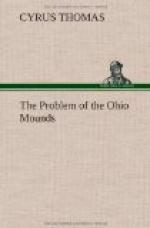Here we also find drills, awls, and perforators, slick stones and dressers, pipes of various forms and finish, discoidal stones and net sinkers, butterflys tones and other supposed ceremonial objects, masks or face figures and bird-shaped stones, gorgets, totems, pendants, trinkets, etc. Nor does the resemblance stop with types, but it is carried down to specific forms and finish, leaving absolutely no possible line of demarkation between these and the similar articles attributed to the mound-builders. So persistently true is this that had we stone articles alone to judge by, it is probable we should be forced to the conclusion, as held by some writers, that the former inhabitants of that portion of the United States east of the Rocky Mountains pertained to one nation, unless possibly the prevalence of certain types in particular sections should afford some data for tribal districting.
This strong similarity of the stone articles of the Atlantic coast to those of the mound area was noticed as early as 1820 by Caleb Atwater, who, knowing that the former were Indian manufactures, attributed the latter also to the same people although he held that the mounds were the work of the ancestors of the civilized nations of Mexico and Central America.
Mound and Indian Pottery.—The pottery of the mound-builders has often been referred to as proof of a higher culture status, and of an advance in art beyond that reached by the Indians. The vase with a bird figure found by Squier and Davis in an Ohio mound is presented in most works on American archaeology as an evidence of the advanced stage of the ceramic art among the mound-builders; but Dr. Rau, who examined the collection of these authors, says:
Having seen the best specimens of “mound” pottery obtained during the survey of Messrs. Squier and Davis, I do not hesitate to assert that the clay vessels fabricated at the Cahokia Creek were in every respect equal to those exhumed from the mounds of the Mississippi Valley, and Dr. Davis himself, who examined my specimens from the first-named locality, expressed the same opinion. [Footnote: Smithsonian Rept., 1866, p. 349.]
The Cahokia pottery which he found along the creek of that name (Madison County, Ill.) he ascribes to Indians, and believes it to be of comparatively recent origin.
Most of the mound pottery is mixed with pulverized shells, which is also true of most Indian pottery. [Footnote: Dumont, Mem. Hist. La., vol. 2, 1753, p. 271; Adair, Hist. Am. Indians, p. 424; Loskiel, Gesell. der Miss., p. 70, etc.] Du Pratz says that “the Natchez Indians make pots of an extraordinary size, cruses with a medium-sized opening, jars, bottles with long necks holding two pints, and pots or cruses for holding bear’s oil;” [Footnote: Hist. La., p. 79.] also that they colored them a beautiful red by using ocher, which becomes red after burning.




